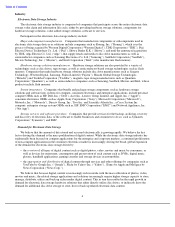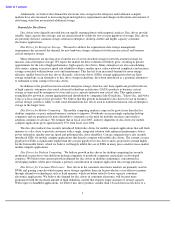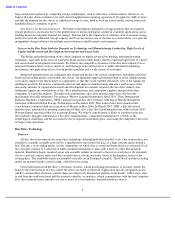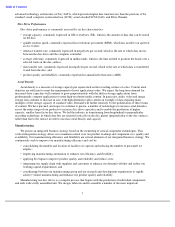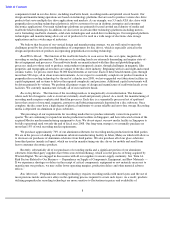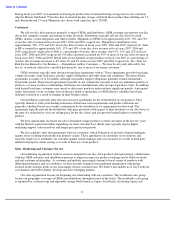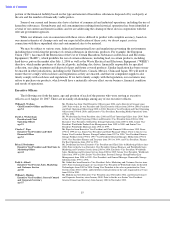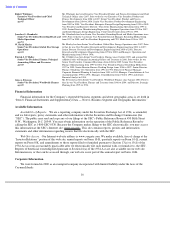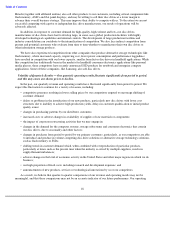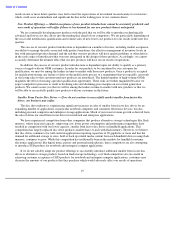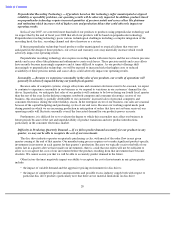Seagate 2006 Annual Report Download - page 17
Download and view the complete annual report
Please find page 17 of the 2006 Seagate annual report below. You can navigate through the pages in the report by either clicking on the pages listed below, or by using the keyword search tool below to find specific information within the annual report.
Table of Contents
Patents and Licenses
As of June 29, 2007, we had approximately 3,857 U.S. patents and 761 patents issued in various foreign
jurisdictions as well as approximately 1,287 U.S. and 651 foreign patent applications pending. The number of patents
and patent applications will vary at any given time as part of our ongoing patent portfolio management activity. Due
to the rapid technological change that characterizes the information storage industry, we believe that the
improvement of existing products, reliance upon trade secret law, the protection of unpatented proprietary know-
how
and development of new products are generally more important than patent protection in establishing and
maintaining a competitive advantage. Nevertheless, we believe that patents are valuable to our business and intend to
continue our efforts to obtain patents, where available, in connection with our research and development program.
The information storage industry is characterized by significant litigation relating to patent and other intellectual
property rights. Because of rapid technological development in the information storage industry, some of our
products have been, and in the future could be, alleged to infringe existing patents of third parties. From time to time,
we receive claims that our products infringe patents of third parties. Although we have been able to resolve some of
those claims or potential claims by obtaining licenses or rights under the patents in question without a material
adverse affect on us, other claims have resulted in adverse decisions or settlements. In addition, other claims are
pending which if resolved unfavorably to us could have a material adverse effect on our business and results of
operations. For more information on these claims, see “Item 3. Legal Proceedings.” The costs of engaging in
intellectual property litigation in the past have been and may be substantial regardless of the merit of the claim or the
outcome. We have patent cross-licenses with a number of companies. Additionally, as part of our normal intellectual
property practices, we are engaged in negotiations with other major disc drive companies and component
manufacturers with respect to ongoing patent cross-licenses.
Backlog
In view of customers’ rights to cancel or defer orders with little or no penalty, we believe backlog in the disc
drive industry is of limited indicative value in estimating future performance and results.
Employees
At June 29, 2007, we employed approximately 54,000 employees, temporary employees and contractors
worldwide, of which approximately 43,000 employees were located in our Asian operations. We believe that our
future success will depend in part on our ability to attract and retain qualified employees at all levels. We believe that
our employee relations are good.
Environmental Matters
Our operations are subject to comprehensive U.S. and foreign laws and regulations relating to the protection of
the environment, including those governing discharges of pollutants into the air and water, the management and
disposal of hazardous substances and wastes and the cleanup of contaminated sites. Some of our operations require
environmental permits and controls to prevent and reduce air and water pollution, and these permits are subject to
modification, renewal and revocation by issuing authorities.
We believe that our operations are currently in substantial compliance with all environmental laws, regulations
and permits. We incur operating and capital costs on an ongoing basis to comply with environmental laws. If
additional or more stringent requirements are imposed on us in the future, we could incur additional operating costs
and capital expenditures.
Some environmental laws, such as the U.S. federal superfund law and similar state statutes, can impose liability
for the cost of cleanup of contaminated sites upon any of the current or former site owners or operators or upon
parties who sent waste to these sites, regardless of whether the owner or operator owned the site at the time of the
release of hazardous substances or the lawfulness of the original disposal activity. We have been identified as a
potentially responsible party at several superfund sites. At each of these sites, the government has assigned to us a
14


